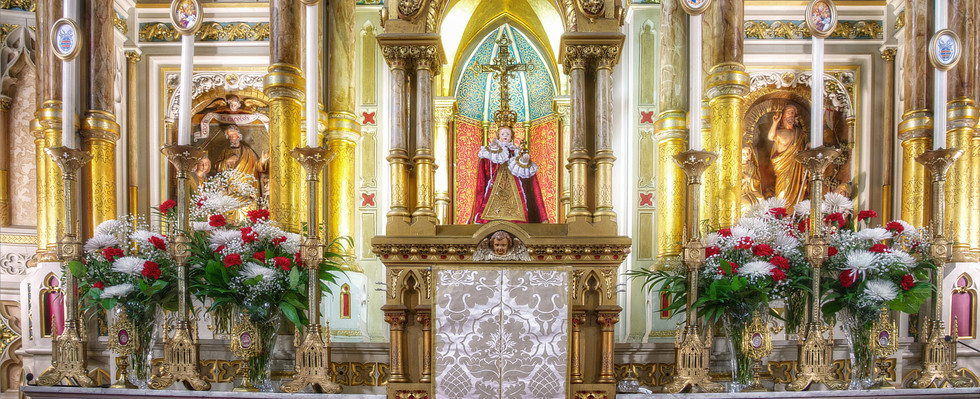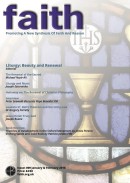Liturgy: Beauty and Renewal
Editorial FAITH MAGAZINE January - February 2016
The timeless Mass
Every Mass takes place across the boundaries of time. Every Mass is one with Christ's one sacrifice on Calvary, every Mass unites us with the saints in Heaven and hence with eternity. Every Mass is “the Mass of all ages”.
Of course, each Mass also has its fixture here in earth: 8, 9 and 11.15 am, on Sunday at St Awfully Ordinary, Parknshopcity, or whatever. The church may be a glory of 19th century gothic revival, or a fearsome 20th century blend of concrete and children's artwork, or perhaps an echoing ancient building in some part of Europe where the Faith was not lost in the religious trauma of the 16th century but now seems to be receding fast in the face of the secularism of the 21st. But the Mass, wherever it is, is always and everywhere the Mass of all time.
“The way of beauty”
It is not always done well. A memory from some years back: a funeral Mass, and while we are still praying quietly after Communion, a member of the family is brought forward and offered a microphone. She tells us about how she loves to write poetry, and recites some trite verses of her own composition about the deceased. A thin ripple of awkward applause. (This happened at a Mass in the Extraordinary Form or, as we called it at the time, the Tridentine Rite. It is not just the Ordinary Form that can be abused in this way).
Liturgy can be a neuralgic issue among Catholics: attempting a serious Editorial on the subject requires some courage. But a recently-canonised Pope, noted for his devotion to the Eucharist told us “Do not be afraid!” and so FAITH magazine takes a breath and goes forward.
The great theologian Hans Urs von Balthasar urged that the Church focus on “the way of beauty”. An encounter with Christ should be an encounter with beauty, and Christians have known this and lived it for centuries: art, architecture, music, poetry, all to the glory of God.
When people drop in to a church, they intuitively expect beauty. They may well be disappointed, but they expect it. They don't necessarily want to be greeted to offered a chat. They haven't come for coffee. If there are votive lights glowing, they will gravitate towards them, and may well light one themselves and be silent for a while. They will be much less likely to pick up a booklet or leaflet. If there is a Visitors' Book, and they have enjoyed their visit, they are likely to express their sentiments by using words like “peaceful” or “lovely” rather than “enjoyable”.
Liturgy
The liturgy should be beautiful. In any prayer, God is really the one who initiates: he seeks us out, he wants to make himself known, he came to live among us. Liturgy is not about the human need to build up a sense of community: it is about connecting humanity with the God who has already made himself known to us.
The Catechism of the Catholic Church quotes St Justin Martyr: “On the day we call the day of the sun, all who dwell in the city of country gather...” and notes that “The liturgy of the Eucharist unfolds according to a fundamental structure which has been preserved throughout the centuries down to our own day. It displays two parts that form a fundamental unity: the gathering, the liturgy of the Word, with readings, homily and general intercessions; the liturgy of the Eucharist, with presentation of bread and wine, the consecratory thanksgiving, and communion” (CCC1346). It then – unusually for the Catechism – poses a question: “Is this not the same movement as the Paschal meal of the risen Jesus with the disciples?”(CCC1347) and it answers the question in the affirmative with a description of Christ on the road to Emmaus in Luke 24: 13-35.
Of all the ages
This section of the Catechism is headed “The Mass of all the ages”. What is happening at Mass cannot accurately be described as simply a celebration in a particular place at a particular time: it always links is directly back to Christ and the Apostles, to the command given by the Lord on the eve of his Passion “Do this...” , to the Cross and Calvary. “The sacrifice of Christ and the sacrifice of the Eucharist are one single sacrifice” (CCC 1366). The Catechism quotes the Council of Trent: “The victim is one and the same: the same now offers through the ministry of priests, who then offered himself on the cross, only the manner of offering is different”.
“In the earthly liturgy we share in a foretaste of that heavenly liturgy towards which we journey as pilgrims...” (Sacrosanctum Concilium). Many readers of this magazine will have uncomfortable memories of earthly liturgies in which that foretaste has been hard to find: banal music, performed into a microphone situated in or near the sanctuary, trite Bidding Prayers read badly, an atmosphere lacking in reverence. But things are changing. Today, it can be noted that as a general rule, the younger the priest, the more formal the liturgy. Younger Catholics use “Kum-by-ya” as a sort of catch-all expression for turgid 1970s ditties they despise and find embarrassing. Eucharistic adoration is today a central feature of major Catholic youth gatherings from World Youth Day to pre-Confirmation retreats, and this in turn has begun to influence attitudes to the Mass, the Tabernacle, genuflecting, being at ease with times of united reverence. Corpus Christi processions, once thought to have been abolished, have made a comeback. Latin chant is heard with increasing regularity.
“Eucharistic amazement”
This is a time of renewal. Pope Saint John Paul's call for a sense of “Eucharistic amazement” has found an echo among the faithful. This is the time to surround the Eucharist with beauty: church, altar, music, all should be a beautiful as possible. This is to give glory to God: it also enables the faithful to pray more deeply. Our participation in the Mass is chiefly in our hearts, but must touch all our senses, so that we are allowed to pray with our voices, to respond aloud to the priest's “The Lord be with you”, to join in when invited to pray “the prayer our Saviour gave us”, to sing, to be able to see and hear, to be aware of the scent of the incense and the flickering of the candles and the gleam of the chalice.
Glorious
Many years back, FAITH magazine published a detailed critique of the then-current translation of the Mass into English, showing its deficiencies. The Church now has a new translation, Deo Gratias. FAITH events used to be unusual in their adherence to the Church's liturgical norms: now that approach is widespread. FAITH has always been broadly sympathetic to the idea that the older form of the Mass should not be banned: this has of course now been established with Summorum Pontificum. FAITH recognised that much was gained with the reforms that took place under Paul VI, including a richer fare of Scripture readings, revival of the Offertory procession, etc, and that what was needed was a sense of continuity, and of adherence to the authentic voice of the Church. That “reform of the reform” is happening now with a sense of normality. Deo Gratias again.“Do not be afraid”. Let us now concentrate on developing that sense of beauty which the very nature of the Mass deserves.
Children and teenagers love to sing glorious music from the rich treasury of the Church's centuries-old heritage, as school choirs prove annually at the Towards Advent Festival in Westminster Cathedral Hall. They learn plainchant easily and sing it well. They link it automatically with worship even if they have not experienced it before learning it in choir: they will tell you that it “feels right” to sing it at Mass. Every Catholic school should teach and use plainchant and have a choir that also sings a range of beautiful church music.
Choirs and Psalms
Parish choirs can do more – often much more – than is often recognised. Psalms can be sung: the dreaded recitation of a line for the “Responsorial psalm” can be replaced with the normality of an easily-learned sung refrain. The Introit can – and should! - be sung. Good music can be something that is given a priority: there can be visits to places where it can be heard, opportunities for plainchant or other music to be learned. This is not difficult: a few sessions can start a whole parish singing a simple Kyrie, Sanctus and Agnus Dei. A project launched by the Association of Catholic Women, “A Day of Art and Music” for primary-school teachers and catechists became a popular event held in various places, with attendees learning some simple chant in the afternoon, and singing it at a Mass as the day finished.
It's not just about music. Readers can – and must! - be properly instructed and spiritually formed, so that the Scriptures are “audible and intelligible” (CCC1154). And all this should be happening in a church where sacred images help to focus the mind on prayer, and where everything used in the liturgy is beautiful and of good quality. And so on.
Last word to Pope Emeritus Benedict XVI. He taught us that beauty in the liturgy “is not mere decoration, but rather an essential element of the liturgical action, since it is an attribute of God himself.”(Sacramentum Caritatis)






